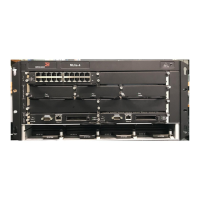Encryption and Decryption of IPv4 Unicast Data and Control Packets
Features include for encryption and decryption of IPv4 unicast data and control packets include IKEv2 on MP; IPSec FPGA protocol;
IKEv2 protocol support; and PKI checks for certicate presence.
Major enhancements to support encryption and decryption of IPv4 unicast data and control packets transmitted or received from
external networks include:
• IPSec FPGA protocol using a new 4x10G/1G and 4x1G IPSec line card, developed to provide hardware based data encryption
and decryption at line rate of 44GBe. This card has free scale P2010 CPU with Security Engine 3.1x.
• IKEv2 protocol support to setup and manage secure tunnels across the external network.
• PKI support for authentication of endpoints of tunnel using digital certicates.
NOTE
The PKI module needs to run over HTTP, so it will be running as a separate task on MP.
IKE or another module should not store the PKI certicates for later reference. Whenever needed, the PKI module
should be queried with the certicate DN or Subject's alternate name.
• Manual PKI is supported, and OCSP and SCEP are not supported (for NetIron Release 5.8.00).
IKEv2 Authentication
When IKEv2 authentication is congured and the method (remote or local) is ECDSA, the CA certicates are retrieved and downloaded to
LPs where IKE will store these certicates. This is done even if the peer is not up, such as during peer init. This data is required or SA-
INIT cannot be completed.
NOTE
The new PKI feature in NI Release 5.8.00 will only be used for setting up the IKEv2 session.
When a peer is created and auth method is ECDSA IKE checks its database to ascertain if the CA and its self certicate are available.
The following certicate payload encoding is supported:
Certicate Type Value
X.509 Certicate – Signature 4
Hash and URL of X.509 certicate 12
OCSP content 14
During the IKEv2 exchange, when two peers are establishing a tunnel, each peer will receive a certicate from the other IKE peer. In the
IKE, the certicates can be sent in two ways: Inline certicate and HTTP and URL format.
NOTE
IKE or another module should not store the PKI certicates for later reference. Whenever needed, the PKI module should be
queried with the certicate DN or Subject alternate name.
Router modules
Brocade NetIron MLXe Series Hardware Installation Guide
46 53-1004203-04

